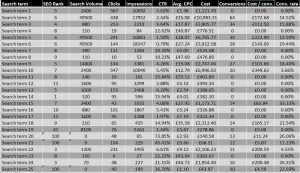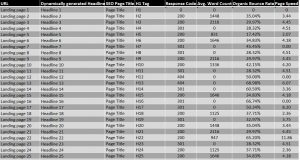With marketers increasingly focused on integrated performance, it’s important for agencies, SEO consultants and paid search specialists alike to have a greater sense of data sharing in order to deliver the most efficient digital campaigns that tie back to overall client KPIs.
This article aims to cover just one of the ways to use PPC Dynamic Search Ad (DSA) data alongside SEO metrics, the range of exports you need to combine, and the questions you need to ask of your data to uncover optimization opportunities for SEM.
DSA: a brief ovierview
As you may know, DSA are auto-generated by Google, matching a user’s search query with the content or product offering of your site. This means that, although you can have incredibly well-oiled ad groups and campaigns set up, a DSA campaign can run alongside this to pick up relevant traffic from longer-tail queries, auto-generating an ad without the need to constantly update your campaign keywords (which is still super important).
By Google’s own admission, DSA ads are populated by Google matching the user query and “AdWords will use these titles and phrases to select a landing page and generate a clear, relevant headline for your ad”. Therefore, there is a clear opportunity to use DSA data to help inform your SEO strategy.
Which reports do you need to export?
The data we need to begin our SEM analysis piece is in the search query report (SQR) for the DSA campaign in question, including the final URL in the export. Google provides information on how to pull this report here.
Once the SQR is downloaded, the next step is to pull the organic ranking information for the search terms listed – note that these terms are only those that have resulted in at least one click and don’t include those that haven’t received any traffic.
When pulling the ranking information, it may also be useful to tag each search term to a category or topic for further data analysis.
The next step is to export data from Google Analytics (or another web analytics solution) to understand the organic performance of these pages for SEO. The key metrics to pull information for are bounce rate and site speed metrics by URL. To get this data in Google Analytics, select page timings under behavior and site speed from the left-hand sidebar, and insert an organic filter on the data to pull this information specifically for SEO.
Once we have the DSA URLs and organic landing pages, we can pull in relevant technical information about these URLs, focusing on:
- Response code
- Page title
- H1
- Average word count.
This should leave four exports that can be combined into one Excel file, under four different tabs.
Under a new master sheet tab, we can stitch the data together at both search term and landing page level, giving us something like this:
Search term-led:
Landing page-led:
NB. Due to the time frame for which we pulled the data, the previous status 200 URLs had changed to 301s and 404s.
SEM analysis and findings
Now that you have your DSA information and corresponding organic data, you can take a closer look at how Google understands the content on the site, the associated cost for PPC, and the potential SEO optimizations.
Landing page mapping
Understand how Google reads your website by examining the query and returned landing page:
- Are there any inconsistencies between the URL you want to rank for organically, and the URL Google is pulling through?
- Does this correlate with any historical ranking decreases you may have seen?
- Does the body content match the ranking URL that differs from the DSA search term?
- What about deviances between SEO Page Titles and the dynamically-generated headline?
High-cost, low conversion queries
This is where we can lean on our analytics data to understand whether anything on page is causing issues:
- Is the landing page bounce rate high?
- Is the page speed above the norm for that vertical and/or your closest competitors?
- What is the mobile versus desktop split for that page and are we optimized accordingly?
High-cost, high ranking queries
These are the queries where we can begin testing with PPC spend and look at the impact on SEM:
- Is there scope for exclusion of these terms?
- Can the account be run more efficiently?
- Are there sections of the site that we can exclude on a landing page basis, such as where traffic is being driven heavily to contact pages? Is there scope for rich snippet implementation organically?
High-cost, low click
This is where we need to understand the on-page elements that aren’t performing for DSA:
- Check the H1 optimization of the page – does the body copy match the query intent?
- Cross-reference against SEO ranking to understand whether Google is indicating that content isn’t relevant here through increased CPCs.
Low-cost, low ranking
This is where we may need to investigate the importance of these terms against the business’ overall KPIs:
- Are these terms worth up-weighting?
- Does SEO need to prioritise this section of the site from a business objective point of view?
- Is new content needed or do we need to amend body copy?
Conclusions
By looking at the above five areas you can start to unlock how Googlebot is reading and understanding the content on your site. This can also be built on when looking at wider metrics such as page speed by URL to contextualize any hypotheses or theories emerging from the data – which may be the beginning of the SEM synergy strategy – and get you and your teams on the way to combining the efforts of both paid and owned to bolster your online strategy.

